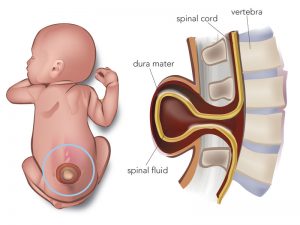The spinal cord and nerves grow outside of the body and are enclosed in a fluid-filled sac that is evident outside of the back region of myelomeningocele, a serious type of spina bifida. Below the sac, these babies typically have weakness and lack of sensation. Muscle weakness and/or paralysis, bowel, and bladder issues, excessive fluid on the brain (hydrocephalus), a shift in brain positioning (Chiari Malformation), seizures, and orthopedic complications are all possible outcomes (scoliosis, hip problems, and foot deformities). Around one out of every 1,000 babies is affected by myelomeningocele.
The most serious type of spina bifida is myelomeningocele. When portions of the spinal cord and nerves pass into the open portion of the spine, this occurs. It causes nerve damage as well as other problems. About 70% to 90% of children with this disorder have too much fluid on their brains (hydrocephalus). This occurs when the fluid that protects the brain and spinal cord fails to drain properly. As the fluid builds up, pressure and swelling grow. Without care, a person’s head may develop too large, resulting in brain damage. Syringomyelia and hip dislocation are two other spinal cord conditions that can be seen. Myelomeningocele has no clear cause. Low folic acid levels in a woman’s body before and during early pregnancy, on the other hand, are thought to play a role in this type of birth defect.
Symptoms of this condition include:
1) Partial or complete lack of sensation
2) Loss of bladder or bowel control
3) Weakness of the hips, legs, or feet
4) Partial or complete paralysis of the legs

